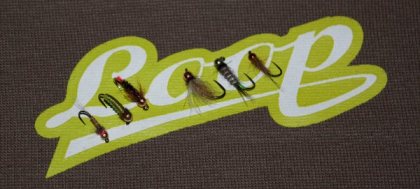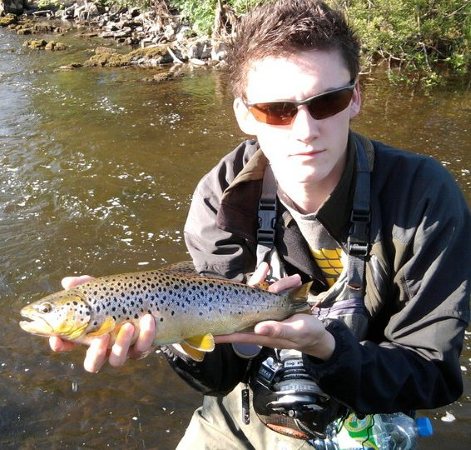Loop Team Member Sean Cassidy on French Nymphing
December 8, 2010 Leave a comment
In recent years French nymphing has surpassed the now well-known and widely practiced style of short line or Czech nymphing. As the name suggests, the art of French nymphing was developed by the outstanding French anglers, born out of a need to present small flies on long leaders to wary trout in their crystal clear streams. Recently it has been utilized by many other nations in international competitions to deadly effect and it has become mine, and many others, favorite nymphing technique due to the advantages it possesses over other styles and its adaptability. Czech nymphing can be hugely effective in certain circumstances but it has limitations when faced with low, clear water and spooky trout, a situation many of us experience on a daily basis.
The disturbance caused by the routine lobbing of a team of nymphs along with a thick fly line can easily spook fish in low, clear water and in a competition every fish counts – there are often no second chances. Many people faced with this situation would turn to dry flies, even if there is no hatch or rise present, and the reason for this is due to the lack of an alternative, effective method. This is where French nymphing comes into play. The logic behind the madness is the fact that no fly line is used, it is obsolete, everything is done just using the leader set up. This reduces line splash and disturbance and increases sensitivity to takes by about 30%, which means a hell of a lot more fish in the net.
Leader set-up: The most important aspect of French nymphing is the leader. It consists of an extremely long tapered leader, up to 9 metres. The butt section has a very large diameter, with a breaking strain of about 50lb, gradually tapering down to around 6 lb. You can make these up yourself or alternatively they are available commercially, specifically designed for the purpose. The reasoning behind the long leader is that no fly line is used in the fishing process; casting is carried out using only the leader, the tapering helping turnover. To the point of this tapered leader a strike indicator of between 6-10” is attached, this can be made from a variety of materials, such as fluorescent braided backing or fluorescent monofilament like the stuff used by sea anglers.
There are many different variations on the indicator used, another beneficial version is one made of coiled monofilament which springs open when a fish takes, useful on slower stretches of river or ultra shy fish due to its extreme sensitivity. Our tippet material is then attached to this section of indicator by means of a loop-to-loop or micro-ring. The length of this depends on the situation obviously due to depth and flow but something around 3-4ft to the first dropper, or even longer if you are using just a single fly is a good starting point. Keep in mind that the further the distance between the flies the more independent they will be of each other and hence act more naturally. It’s a good idea to use a soft and thin diameter fluorocarbon or copolymer such as Loop Crystal Dense or Loop nylon tippet as the suppleness of the material aids the natural movement of the nymphs through the water which is very important and the thin diameter also allows the nymphs to sink much faster. Usually 6X – 8X is sufficient although you may need to decrease in diameter if the fish are proving difficult or increase it if you are dealing with large fish.
Sticks and reels: It is important to have a long rod with a light line rating for sensitivity and to deal with casting just the leader and fighting big fish on light tippets. The Loop Opti Peak 11’ #3 is the mother of all in this respect with its sensitive tip action increasing take-detection and reducing breakages. Its light weight also helps you put more hours in on the water as holding a heavy rod at arm’s length for an extended period can get uncomfortable, so it is also important to have a reel which balances the rod correctly, has a sensitive drag to protect tippets, and has a large arbour to keep memory coils in the leader to a minimum, a Loop Opti Dryfly or Runner fits in here perfectly, it doesn’t hurt that it looks great too!
Items to go: Nymphs between the sizes of 14-20 are used most often here on Irish rivers but you can use whatever works well for you. Nearly all my nymphs are tied using tungsten beads as they are twice as dense as lead and allow the nymphs to gain depth quickly, keeping a slim profile on the nymphs also helps this. Some of my favourite nymphs are variations on pheasant tails, hares ears and stripped quills.
Method: Stealth is vitally important while French nymphing, or for any other method, so approach the water keeping a low profile, generally on your knees or behind cover and fish the margins of the river along the bank before entering the water while still keeping a low profile. The flies are flicked upstream or into pockets and depressions with a very positive forward cast, stopping the rod tip high to allow the nymphs to drop in first and gain depth. The movement should be minimal, just a flick of the wrist. The high rod tip and outstretched arm is maintained allowing just the indicator to touch the water’s surface and tracked downstream, watching the indicator carefully for takes, and keeping your index finger on the butt of the rod blank as this increases sensitivity to takes, especially when jigging the nymphs through slack water. When the end of the drift is reached allow the nymphs to continue their journey downstream while dropping the rod tip in sync with the flow, a lot of takes will come as the nymphs lift up imitating hatching insects so be prepared. Always make a flick of the rod tip to strike while lifting your flies from the water in one controlled movement as a fish may have taken and you might not have noticed, you’d be surprised how often this happens.
Treat the water in front of you like an imaginary grid and systematically cover all of the water before moving on as fish will lie in all parts of a river, although don’t waste your time in unproductive sections, you will know when it’s time to move on. Don’t let the wool be pulled over your eyes though, this method is very effective even in heavy, deep water, just adjust to suit with a longer leader and/or heavier flies. In essence, get optimised!

